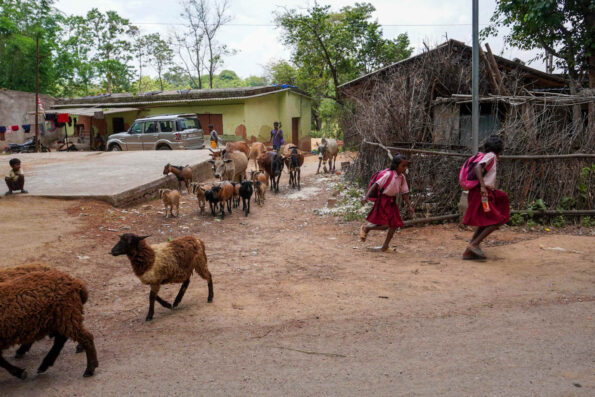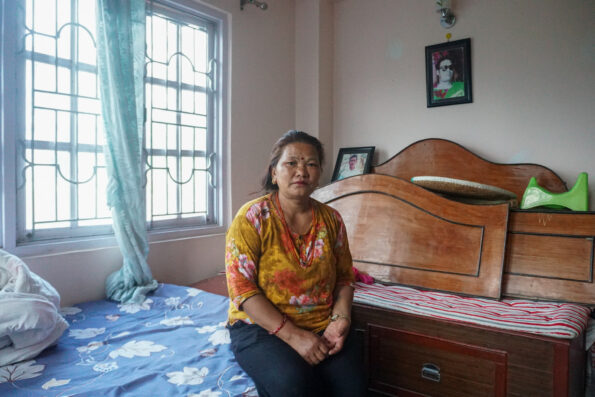
Marissa Revilla, GPJ Mexico
Santiago Jiménez Díaz, 70, next to his wife, Maria, holds a photo of their son Marciano, 44, who left their Chiapas home for the U.S. 14 years ago.
SAN CRISTÓBAL DE LAS CASAS, MEXICO — For decades, many Mexicans have depended on funds sent from family members living abroad, especially from relatives in the U.S. In 2016, they received a record amount — $26.97 billion, with 95 percent of that coming from family members in the U.S., according to Mexico’s central bank, Banco de México.
The all-time high in remittances, which swelled to nearly $2.5 billion in December, likely was motivated by several factors, all of them having to do with uncertainty, says Eliseo Díaz González, a researcher in the economics department of El Colegio de la Frontera Norte, an academic institution focused on the Mexico-U.S. border.
SOLUTION SPOTLIGHT:
Daniel Tacher, 39, the coordinator of citizen coalition Observatorio Binacional, part of the Iniciativa Ciudadana para la Promoción de la Cultura del Diálogo, is working to put in place a support system for immigrant families. It would involve a network of consulates, schools, community organizations and sanctuary city governments to aid immigrant families in preparing for likely changes in U.S. policy, including any changes in the flow of remittances. His organization works with the Mexico City government to support immigrants who live in Los Angeles and Chicago. Assistance would include receiving documents like birth and death certificates, marriage licenses and divorce papers for free.
Fear of deportation, risks that the cost of transferring funds would increase and the concern that savings could be confiscated all played a role, he says.
“I believe that the scenario that they are creating is the worst,” Díaz González says.
Fears of such a worst-case scenario increased after Donald Trump’s Nov. 8 election, and escalated on Jan. 25 with an executive order that broadened the profiles of immigrants considered a deportation priority. A Feb. 20 U.S. Department of Homeland Security memo implementing the executive order calls for hiring an additional 5,000 border patrol agents, as well as expediting removal of those whose claims for protection have been denied.
The measure is expected to affect Mexican immigrants the most, because they represent 53 percent of the 11.1 million undocumented immigrants in the U.S., according to the Pew Research Center.
Mexico is the fourth-biggest recipient of remittances in the world, according to the World Bank. Incoming funds aren’t taxed, and are a steady source of foreign currency for Mexico, comprising between 1.8 percent and 2.8 percent of Mexico’s gross domestic product during the last decade, according to a 2016 annual directory of migration and remittances in Mexico, edited by the Consejo Nacional de Población, a federal census department, and the Fundación BBVA Bancomer y BBVA Research, a private financial group and its members. Senders pay a commission charge ranging from $5.80 to $8.90 per $300.
Four of every 100 Mexican families benefit from remittances. About half of the recipients are in rural communities, and nearly half have heads of households who have not finished grade school. Remittances are used mainly for food and clothes, debt payments and home improvements.
Chiapas, Mexico’s poorest state, received $576 million in remittances in 2016. Global Press Journal interviewed Chiapas residents who spoke about the importance of the remittances that their family members send, and their fears and hopes, given recent uncertainly about this income.
REYNA VILLATORO HERNÁNDEZ



Last year was one of contradictions for Reyna Villatoro Hernández, 59. She was happy because her son, who left home for the U.S. nearly 13 years ago when he was 19, came back to visit. But she was also somber because she feels that the risks increased for him and other migrants once Donald Trump won the U.S. presidency.
“My son is somewhat fearful of being deported, even though his papers are in order,” she says. Because he was only able to complete the procedure to obtain legal residency in 2016, “he’s afraid they’ll take it from him and he’ll be deported.”
When her son, L.M. Méndez Villatoro, left home, he planned to stay in the U.S. for two years, she says. But he found jobs in agriculture, construction and most recently as a mechanic for heavy machinery. Currently he works at an ironworks in Kentucky.
Villatoro Hernández says that she and her husband split the money their son sends home into two portions: one for savings and investment in a vegetable garden, and the other for expenses.
When her son visited Mexico last year, she says, he also had mixed emotions. While he was happy to see the garden, he also feared being separated from his wife, his daughter, 5, and son, 3, both of whom were born in the U.S. But those fears are unlikely and would be illegal since he married a U.S. citizen.
TERESA SANTIS DÍAZ



Teresa Santis Díaz, 22, is originally from the indigenous community of Cruztón, in the V Altos Tsotsil Tseltal region of Chiapas. In 1994, when she was 1 year old, Santis Díaz immigrated to the U.S. with her parents and siblings.
In 2003, Santis Díaz, her parents and two younger siblings returned to Chiapas, where her father was due to fulfill a traditional community role or face a fine, which she says the family couldn’t afford. Her two older brothers and older sister remained in the U.S. to help support the family. They worked on farms and construction sites.
Their decision to stay was made because of the family’s multiple debts and necessities, she says.
“Our home used to be of mud; it wasn’t like today’s material, of brick. And also my family had a lot of debt at that time,” Santis Díaz says. Eventually the remittances enabled the Díaz family to build a better home.
In 2016, Santis Díaz’s two younger siblings, A. Santis Díaz, 21, and M. Santis Díaz, 19, emigrated to the U.S. as well. A. Santis Díaz went on the migrant trail using a coyote, or smuggler, to cross the desert. M. Santis Díaz was able to travel as a U.S. citizen because he was born there.
Both siblings found work in Georgia on farms. “They didn’t go without reason; but rather because they want to support us,” Teresa Santis Díaz says.
“They’re working in the field, the same that they worked here, in cultivating the field. But here we don’t have a salary. The little you cultivate and are able to sell is for daily expenses. There’s no surplus,” she says. “But over there, it’s not like that. In the United States, you do have a salary, and you can save to get a little property in Mexico.”
Buying property is not yet on the agenda, though. Santis Díaz says the family first must pay the debt of more than 100,000 pesos (nearly $5,000) that her brother had to pay to cross the border.
“My brother who doesn’t have papers is really scared, because he just left and hasn’t saved much to be able to pay his debt,” she says. “He thinks that he only got himself into debt and won’t be able to pay it off because Trump will likely deport him soon.”
M. Santis Díaz, despite having U.S. citizenship, is also afraid because of rumors that even he could be deported under Trump’s policies, Teresa Santis Díaz says.
She too once thought she’d like to return to the U.S. to study and work.
“Before, I did want to go,” she says. “But now that Donald Trump arrived, I’m afraid to just create debt to get there, and they’d deport me quickly, and I wouldn’t have enough time to pay my debt. I’m not going now.”
SANTIAGO JIMÉNEZ DÍAZ
Santiago Jiménez Díaz says his son, Marciano, left for the U.S. 14 years ago.
Santiago Jiménez Díaz, 70, an indigenous farmworker who lives in a community called Los Llanos in the V Altos Tsotsil Tseltal region in Chiapas, hasn’t seen his son Marciano Jiménez Díaz, 44, for more than 14 years.
Marciano Jiménez Díaz left to get a better-paying job than he could find in Chiapas, his father says.
“There’s work [here], but it’s poorly paid. Poorly paid. Our harvests, of corn and beans, sometimes don’t come through,” Santiago Jiménez Díaz says.
His son sends about 10,000 pesos (almost $500) every two or three months to his family for their expenses and to buy a small property.
Santiago Jiménez Díaz says his son lives in Virginia and has tried multiple times to secure permission for residency through paperwork and payments, but he’s never been able to. And now Santiago Jiménez Díaz fears that it will be even more difficult.
“Donald Trump wants to kick out all Mexicans in the United States,” he says. “He doesn’t want immigrants there anymore, anywhere. He wants everyone out.”
Marciano Jiménez Díaz’s brothers, Jaime Jiménez Pérez, 31, and Humberto Jiménez Pérez, 33, say their brother is considering moving from the U.S. to Canada, where they believe he would not be in danger of deportation.
“They say that between Mexico and Canada there’s an agreement and they’ll receive you without a visa, and there are work opportunities there,” says Humberto Jiménez Díaz. As of Dec. 1, 2016, Canada no longer requires Mexicans to have a visa to cross its border.
Marissa Revilla, GPJ reporter, contributed reporting.
Danielle Mackey, GPJ, translated this article from Spanish.










